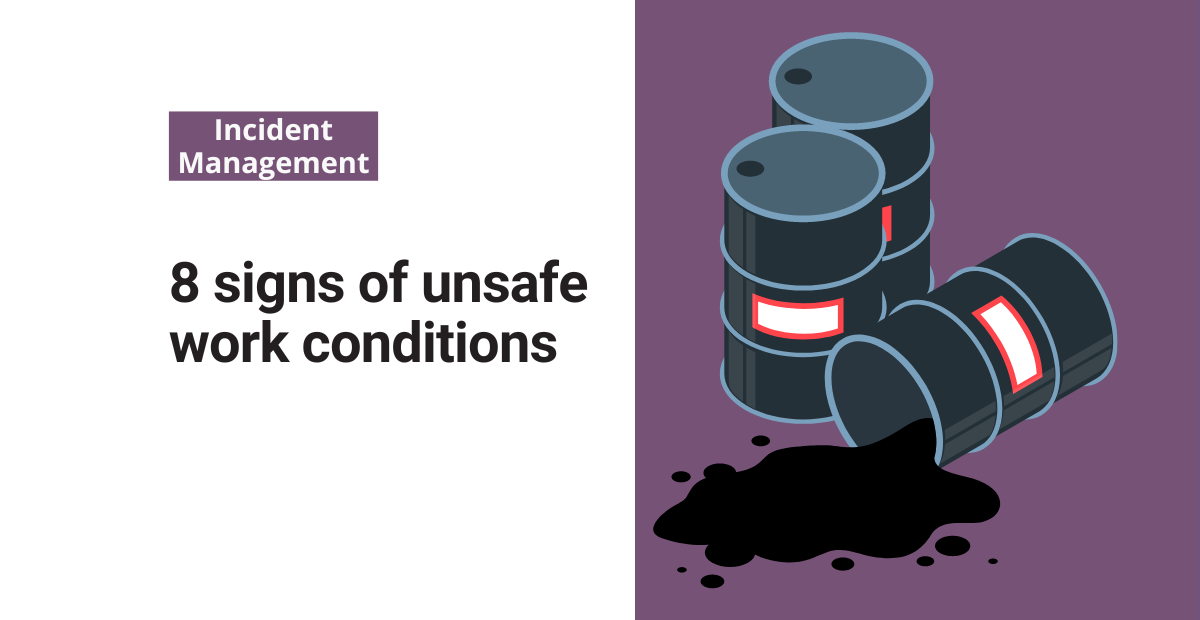According to the Bureau of Labor Statistics, “private industry employers reported 2.6 million nonfatal workplace injuries and illnesses in 2021.” And this figure doesn’t even account for the fatalities that occur each year due to unsafe work conditions.
Being able to quickly recognize workplace hazards is an essential skill for incident prevention. Luckily, you can train yourself to spot dangerous situations on the spot, making it easier to avoid an injury or fatality altogether.
Here are 8 signs of unsafe work conditions that you should be able to recognize. Commit them to memory and expand your ability to find and address hazards right away.
Dangerous work conditions
Some unsafe conditions are more obvious than others. Hopefully, you can use these general signs to dig deeper and get to the heart of workplace hazards.
Messy workstations
One of the most obvious—yet somehow most rampant—unsafe working conditions is a messy workspace. Having a lack of organization immediately increases incident risk and must be avoided at all costs. Luckily, disorganization is one of the more straightforward issues to solve, although it may require some trial and error to settle on the best setup.
Missing safety guards
OSHA’s machine guarding standard exists for a reason—unguarded equipment provides a serious hazard to workers. Missing safety components are the hallmark of an unsafe work environment. After all, if workers aren’t protected from the most dangerous equipment in the facility, how many smaller hazards do they encounter throughout the day as well?
Excessive clutter
Clutter creates trip and fall hazards, blocks emergency exits, and can even cause fire hazards (among others). If your worksite is cluttered, it also means that your workers may not care about their personal safety, which is arguably the biggest safety concern of all.
Broken tools or equipment
Broken equipment is a major hazard in and of itself. When workers attempt to use faulty tools, they can hurt themselves, but they can also create more unsafe conditions for their coworkers.
Noticeable rusting
Equipment and/or structural components with excessive rusting pose a potential safety threat to your workers and customers. Corrosion control is an essential practice for ensuring the longevity of machinery and the safety of consumer products.
Dress code violations
Personal accountability for workplace safety is a type of hazard that’s often overlooked. Failing to adhere to grooming and dress code standards can actually create an unsafe work condition for the entire team—not just the individual.
Modified equipment
Making modifications to process equipment is risky without the proper approach. If you notice any makeshift or modified equipment, chances are that there’s a safety incident waiting to happen.
Frequent process incidents
Identifying patterns is the key to unlocking incident root causes. If you notice that a high percentage of incidents come from a specific process, it may be a sign of unsafe work conditions within that area.
Document your observations
You can’t be everywhere at once, so it’s unrealistic to expect that you can stop all workplace injuries from happening. But when you walk the floor and address unsafe working conditions right away, you inadvertently teach your workers to do the same.
Keeping an eye out for these signs means you have a better chance of protecting workers not only from dangerous equipment and processes, but possibly their own behaviors as well.
Take your incident prevention strategy to the next level by upgrading to EHS corrective action software. This kind of software solution allows you to create action items for the unsafe work conditions that you come across.
It gives you the ability to assign owners and deadlines to corrective actions, helping to ensure they’re completed in a timely manner.
Other posts you might like…
No posts

